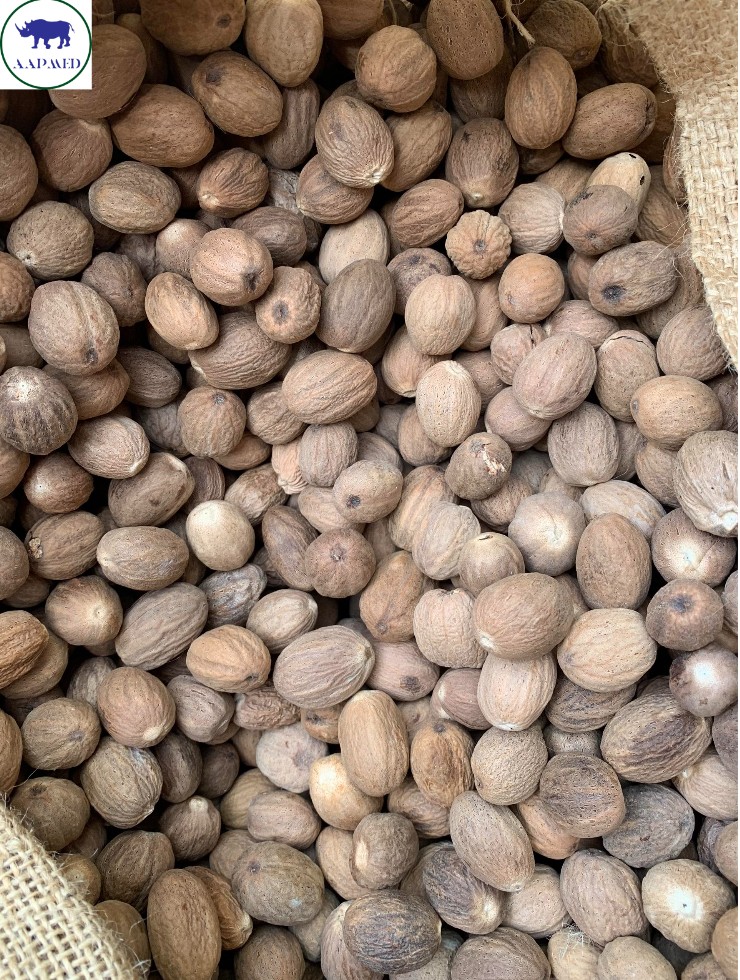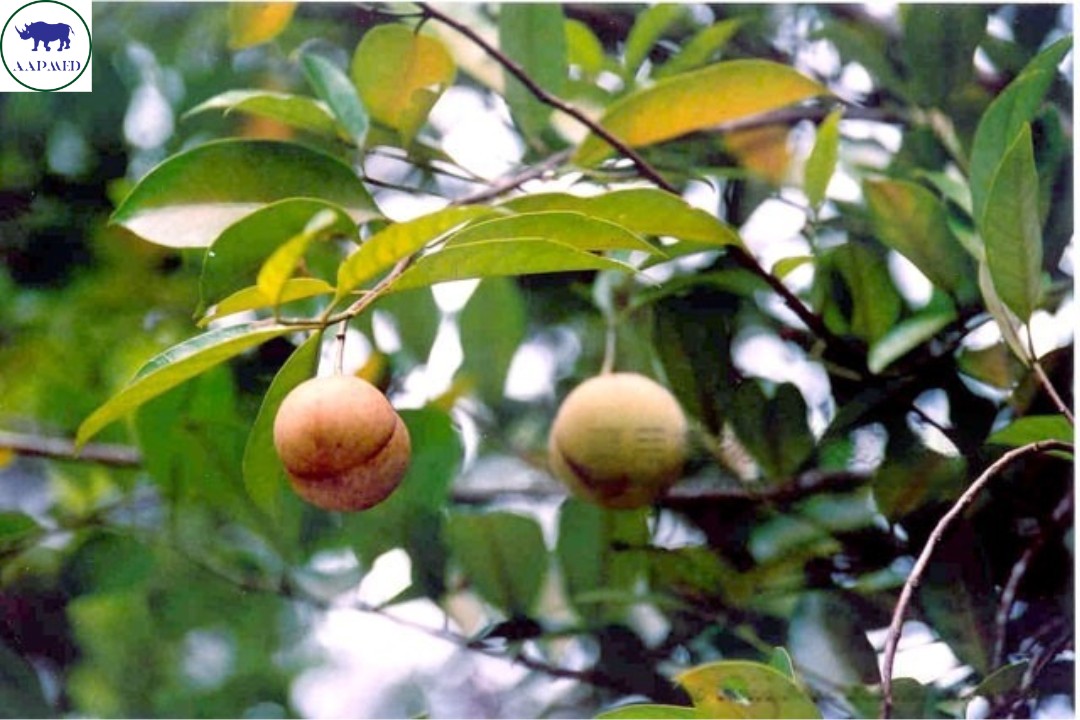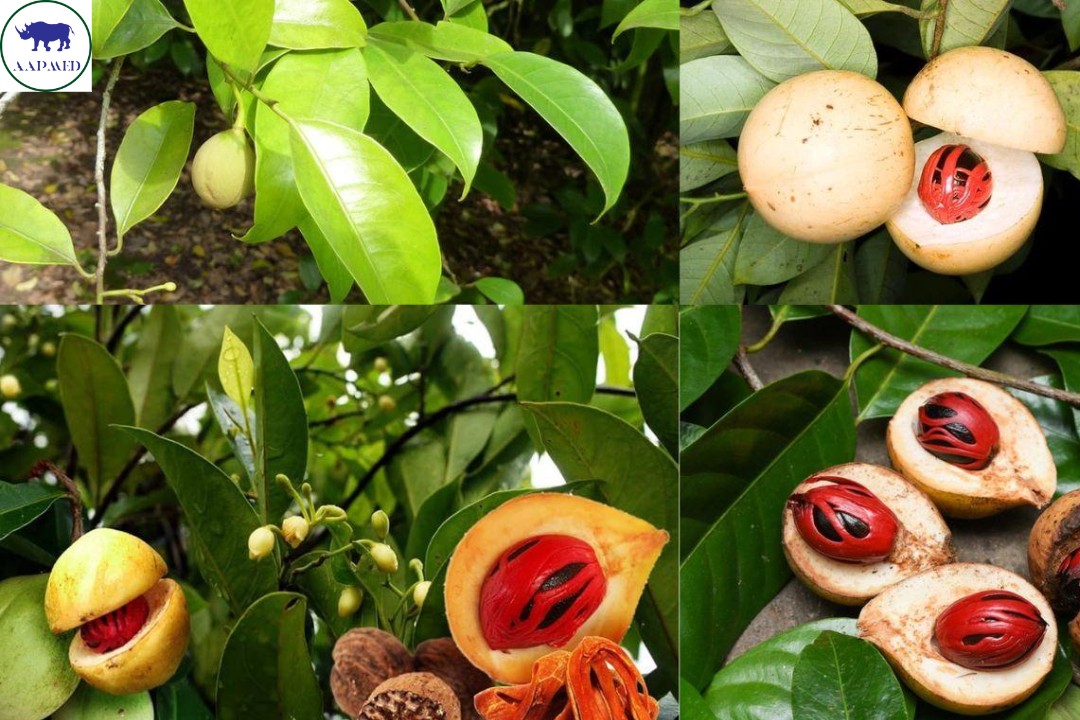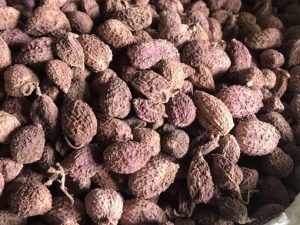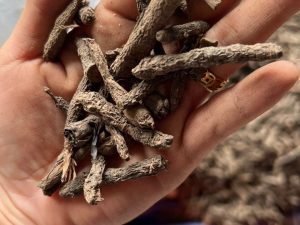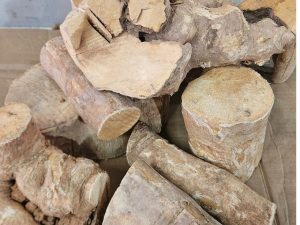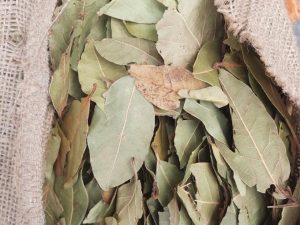Roudoukou – 肉豆蔻 – Common Nutmeg
Roudoukou – 肉豆蔻 – Common Nutmeg
Chinese Name: 肉豆蔻
Chinese Pinyin: Roudoukou
English Name: Nutmeg, Common Nutmeg, Common Nut-meg, Mace
Latin name: Myristica fragrans Houtt. Handleid Hist. Nat. Linn.
Science Name / Latin Pharmaceutical Name: Myristicae Semen
– Parts of plants that have useful value: Fruits and seeds
– Origin: The dried kernel of Myristica fragrans Houtt.(Myristicaceae).
– Family & Genus: Myristicaceae, Myristica
Roudoukou – 肉豆蔻 – Common Nutmeg
名稱: 肉豆蔻
中文名稱: 肉豆蔻,迦拘勒,豆蔻,肉果,頂頭肉,扎地
漢語拼音: Roudoukou
英文名稱: Nutmeg, Common Nutmeg, Common Nut-meg, Mace
– 拉丁學名: Myristicae Semen, Myristica fragrans Houtt. Handleid Hist. Nat. Linn.
– 科屬歸類: 肉豆蔻科 Myristicaceae, 肉豆蔻屬 Myristica
– 類別: 果實及種子類
– 來源: 肉豆蔻科植物肉豆蔻Myristica fragrans Houtt.的乾燥種仁。
Description
Roudoukou – 肉豆蔻 – Common Nutmeg
Chinese Name: 肉豆蔻
Chinese Pinyin: Roudoukou
English Name: Nutmeg, Common Nutmeg, Common Nut-meg, Mace
Latin name: Myristica fragrans Houtt. Handleid Hist. Nat. Linn.
Science Name / Latin Pharmaceutical Name: Myristicae Semen
– Parts of plants that have useful value: Fruits and seeds
– Origin: The dried kernel of Myristica fragrans Houtt.(Myristicaceae).
– Family & Genus: Myristicaceae, Myristica
-
- Distribution Cultivated in tropical regions Malaysia, Indonesia, Sri Lanka, Vietnam, as well as in Taiwan, Guangdong, Guangxi and Yunnan, etc.
Production Regions: Primarily produced in Malaysia, Indonesia, Sri Lanka, Guangdong, Guangxi, Yunnan. - Harvest & Processing: collected mature fruits, removed the pericarp, picked off the aril, gradually baked the kernel by 45 ℃ low temperature, often turning over, stop baking when the kernels are sounding when shaking. Aril: collected mature fruits, taken out the kernel (nutmeg), put the fresh arils in shed, air drying to bright in color and shrinking, then press them flat, sun-dried until the color become orange red from bright red.
Description: Evergreen undershrubs, as tall as 15m. Young branches thin and long; leaves alternate, leathery, elliptic or elliptic lanceolate, 4-8cm long, apex short acuminate, base cuneate or nearly circular, entire, both surfaces glabrous, lateral veins 6-10 pairs; petiole 0.6-1.2cm long. Male inflorescence racemous drooping, 2.5-5cm long, has flowers 4-8 or more, flowers 4-5mm long; tepals 3 (4), densely grey brown tomentous; female inflorescence longer than male inflorescence, peduncle sturdy, has flowers 1-2, flowers ca. 6mm long, tepals 3, densely tomentulose, peduncle ca. 8mm long, bractlets inserted in perianth base; ovary elliptic, style quite short, 2 lobed. Infructescence has fruits 1-2, 3.5-5cm long; fruits pear shaped or nearly spheric. Seed 1, woody, ovate, 2-3cm long, ca. 2cm in diam. - Macroscopic Features: Oval or elliptical shape, 2~3cm long, 1.5~2.5cm diameter. Externally grayish-brown or grayish-yellow, sometimes externally covered in white powder (lime powder). Whole body has pale longitudinal grooves and irregular grooves. Hilum is located in the wide end; pale round and raised, chalaza is dark and indented. Raphe is longitudinal groove connecting the two ends. Firm texture, fractured surface has a brownish-yellow alternating pattern, wide end has dry wrinkled embryo, oily. Potent aromatic odor, acrid taste.
- Part Used Medical part: kernel and aril. Chinese name: kernel: Roudoukou. Aril: Roudoukouyi.
- Quality Requirements: Superior medicinal material is large, externally purplish-brown lustrous, with full and white kernel.
Chemistry: contains trimyristin, and a little fatty oil such as triolein, sabinene, limonene, bornylene, myristicin, citronellol, p-cymene, myrcene, linalool, cis and trans-Resveratrol and eugenol. Aril contains myristicin, elemicin, eugenol methyl ether, safrole, propyl alcohols, guaiacin, fragansin, fragransol, myristicanol, verrucosin, nectandrin B, verrucosin and anthriscinol, etc. - Pharmacology: having effect on smooth muscle of stomach and intestine, sedative and anti-tumor, anti-inflammatory; toxic. Aril: having effect on glutathione S-transferase.
- Properties:
- Seed nut: Acrid, taste pungent, little bitter, warm in nature.
- Aril: Acrid, taste pungent, warm in nature.
- Indications: Warms the middle, astringes intestines, moves qi, resolves food.
- Kernel: used for diarrhea of deficiency type, cold dysentery, gastric and abdominal swelling pain, poor appetite and vomiting, indigestion. warming inside, inducing astringency bowel, activating qi-flow and promoting digestion.
- Arillus: used for distention of stomach and abdomen, anorexia, vomiting and diarrhea, aromatic and tonifying stomach.
- Usage
- Kernel: oral administration: decocting, 1.5-6g; or made as pills or powders. Not use in case of damp-heat and diarrhea and hyperactivity due to yin deficiency.
- Aril: oral administration: decocting, 1.5-5g.
- Examples
- Long lasting diarrhea and dysentery, asthenia cold of intestine and stomach, dreg not aggregated: Nutmeg (cooked), white lead (stir-fried), bone fossil of big mammals (calcined), alumbre (calcined) of equal amount. Grind into powder, prepare paste pills. Measure the pill size and swallow with rice water.
- Weakness of the spleen and the stomach, lingering diarrhea, dysentery with red and white feces, not drug indicated: Nutmeg (cut into pieces, stir-fried to yellow), opium poppy shell (pestle into pieces, mix evenly with honey, stir fry to black, yellow), ural licorice (cut into pieces, stir-fried to yellow black), dry ginger (cut into pieces, stir-fried to yellow black). Take the above drugs of equal amount, grind into powder, and take 25g each time.
- Technical Terms ‘Bing lang lines’: Also called areca-markings, this refers to a pattern of alternating deep and light colors on the surface or fractured surface of medicinal materials. It appears similar to the pattern seen on the fractured surface of bing lang(areca nut), and is also called a ‘marbled pattern(da li shi hua wen)’.
- Distribution Cultivated in tropical regions Malaysia, Indonesia, Sri Lanka, Vietnam, as well as in Taiwan, Guangdong, Guangxi and Yunnan, etc.
Roudoukou – 肉豆蔻 – Common Nutmeg
名稱: 肉豆蔻
中文名稱: 肉豆蔻,迦拘勒,豆蔻,肉果,頂頭肉,扎地
漢語拼音: Roudoukou
英文名稱: Nutmeg, Common Nutmeg, Common Nut-meg, Mace
– 拉丁學名: Myristicae Semen, Myristica fragrans Houtt. Handleid Hist. Nat. Linn.
– 科屬歸類: 肉豆蔻科 Myristicaceae, 肉豆蔻屬 Myristica
– 類別: 果實及種子類
– 來源: 肉豆蔻科植物肉豆蔻Myristica fragrans Houtt.的乾燥種仁。
-
- 植物形態: 常綠小喬木,高達15米。幼枝細長;葉互生,革質,橢圓形或橢狀披針形,長4-8厘米,先端短漸尖,基部寬楔形或近圓,全緣,兩面無毛,側脈6-10對;葉柄長0.6-1.2厘米。雄花序總狀下垂,長2.5-5厘米,具4-8花或多花,花長4-5毫米;花被片3(4),密被灰褐色絨毛;雌花序比雄花序長,花序梗粗壯,具1-2花,花長近6毫米,花被片3,密被微絨毛,花梗長約8毫米;小苞片著生花被基部;子房橢圓形,花柱極短,2裂。果序具1-2果,長3.5-5厘米;果梨形或近球形,淡黃色、黃或橙黃色,具短柄,有時具殘存花被片,假種皮肉質紅色,不規則撕裂。種子1,木質,卵圓形,長2-3厘米,徑約2厘米。
- 性狀: 該品呈卵圓形或橢圓形,長2~3cm,直徑1.5~2.5cm。表面灰棕色或灰黃色,有時外被白粉 (石灰粉末) 。全體有淺色縱行溝紋及不規則網狀溝紋。種臍位於寬端,呈淺色圓形突起,合點呈暗凹陷。種脊呈縱溝狀,連接兩端。質堅,斷面顯棕黃色相雜的大理石花紋,寬端可見乾燥皺縮的胚,富油性。氣香濃烈,味辛。
- 生境分佈: 栽培於熱帶地區,我國台灣、廣東、廣西、雲南等地引入栽培。 藥材主產馬來西亞及印度尼西亞等地、斯里蘭卡等地。
- 採收加工:
- 種仁: 採摘成熟果實,除去果皮,剝去假種皮,將種仁用45℃低溫慢慢烤乾,經常翻動,當種仁搖之作響時即可。
- 假種皮: 採摘成熟果實,取出種仁(肉豆蔻)后,將新鮮的假種皮放在棚內風乾至色澤發亮,皺縮,再壓扁,曬乾,使從鮮紅色變成橙紅色即可。
- 藥用部位: 以種仁、假種皮入藥。中藥名: 種仁: 肉豆蔻。假種皮: 肉豆蔻衣。
- 主要成分: 種仁含三肉豆蔻酸甘油酯(trimyristin)和少量三油酸甘油酯(triolein)等脂肪油,香檜烯(sabinene)、檸檬烯(limonene)、冰片烯(bornylene)、肉豆蔻醚(myristicin)、香茅醇(citronellol)、對聚傘花素(p-cymene)、月桂烯(myrcene)、芳樟醇(linalool),順/反式辣葡萄醇、丁香油酚(eugenol)等揮髮油。假種皮含肉豆蔻醚(myristicin),欖香脂素(elemicin),丁香油酚甲醚類,黃樟醚(safrole),丙醇類,愈創木脂素(guaiacin),肉豆蔻脂素(fragansin),肉豆蔻脂醇(fragransol),肉豆蔻衣脂醇(myristicanol),肉豆蔻衣木脂素(verrucosin),甘密脂素B(nectandrin B),渥路可脂素(verrucosin),峨參屬脂醇(anthriscinol)等。
- 藥理作用:
- 種仁: 影響胃腸平滑肌,鎮靜,抗腫瘤,抗炎及具毒性。
- 假種皮: 影響谷胱甘肽S轉移酶。
- 品質: 以個大、表面具紫褐色光澤、仁飽滿、色白者為佳。
- 性味
- 種仁: 味辛、微苦,性溫。
- 假種皮: 味辛,性溫。
- 主治用法 / 功能:
- 種仁: 溫中澀腸,行氣消食。用於虛瀉;冷痢;脘腹脹痛;食少嘔吐;宿食不消。
- 假種皮: 芳香健胃和中。用於脘腹脹滿,不思飲食,吐瀉。
- 應用舉例: 種仁
- 內服: 煎湯,1.5-6克;或入丸、散。濕熱瀉痢及陰虛火旺者禁服。
- 1. 瀉痢日久,腸胃虛寒,腸滑,糟粕不聚: 肉豆蔻(煨)、胡粉(炒)、龍骨(煅)、白礬(煅)各等分。為末,糊丸。量大小,米湯下。(嬰童類萃)
- 2. 脾胃虛滑,泄瀉不止,下痢赤白,無藥可治: 肉荳蔻(切作片子,炒黃色)、罌粟殼(搗碎,用蜜拌勻,炒黑黃)、甘草(切碎,炒黃黑色)、乾生薑(切細,炒黃黑色)。上各等分為末,每服25克。(衛生家寶)
- 注解: “檳榔紋”:指藥材表面或斷面呈深淺色相間的花紋,如同檳榔斷面的紋理,也稱為“大理石花紋”。
- 假種皮: 內服: 煎湯,1.5-5克。
- 注解 “檳榔紋”:指藥材表面或斷面呈深淺色相間的花紋,如同檳榔斷面的紋理,也稱為“大理石花紋”

